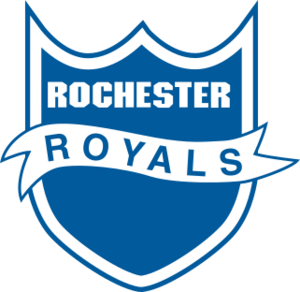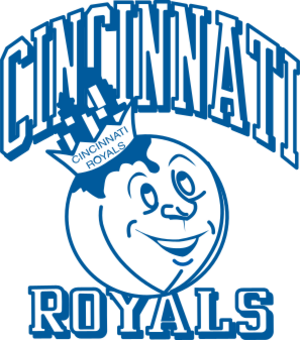Sacramento Kings facts for kids
Quick facts for kids Sacramento Kings |
|||||
|---|---|---|---|---|---|
 |
|||||
| Conference | Western | ||||
| Division | Pacific | ||||
| Founded | 1923 | ||||
| History | Rochester Seagrams 1923–1942 Rochester Eber Seagrams 1942–1943 Rochester Pros 1943–1945 Rochester Royals 1945–1948 (NBL) 1948–1957 (BAA/NBA) Cincinnati Royals 1957–1972 Kansas City-Omaha Kings 1972–1975 Kansas City Kings 1975–1985 Sacramento Kings 1985–present |
||||
| Arena | Golden 1 Center | ||||
| Location | Sacramento, California | ||||
| Team colors | Pure black, royal purple, gray, white, royal blue |
||||
| Main sponsor | Reviver | ||||
| President | John Rinehart | ||||
| General manager | Scott Perry | ||||
| Head coach | Doug Christie | ||||
| Ownership | Vivek Ranadivé | ||||
| Affiliation(s) | Stockton Kings | ||||
| Championships | 2 NBL: 1 (1946) NBA: 1 (1951) |
||||
| Conference titles | 0 | ||||
| Division titles | 6 (1949, 1952, 1979, 2002, 2003, 2023) | ||||
| Retired numbers | 11 (1, 2, 4, 6, 11, 12, 14, 16, 21, 27, 44) | ||||
|
|||||
The Sacramento Kings are a professional basketball team from Sacramento, California. They play in the National Basketball Association (NBA) as part of the Western Conference's Pacific Division. The Kings are the oldest team in the NBA. They were also the first major professional sports team to be based in Sacramento. Their home games are played at the Golden 1 Center.
The team started in 1923 as the Rochester Seagrams in Rochester, New York. They joined the National Basketball League (NBL) in 1945 as the Rochester Royals. They won the NBL championship in their first season, 1945–46. In 1948, they moved to the Basketball Association of America (BAA). The BAA later joined with the NBL to form the NBA. As the Royals, the team won the NBA championship in 1951. The team then moved to Cincinnati in 1957, becoming the Cincinnati Royals.
Before the 1972–73 season, the team moved again to Kansas City, Missouri. They were renamed the Kansas City–Omaha Kings because they played games in both Kansas City and Omaha, Nebraska. The name "Kings" was chosen to avoid confusion with the baseball team, the Kansas City Royals. After three seasons, they became just the Kansas City Kings. They continued to play some games in Omaha until March 1978.
The team moved to Sacramento after the 1984–85 season. Their best years in Sacramento were in the early 2000s. In the 2001–02 season, they had the best record in the NBA, winning 61 games and losing 21. Between 2006 and 2022, the Kings had 16 losing seasons in a row. This was the longest streak in NBA history. They also had the longest time without making the playoffs in major North American sports, from 2006 until 2023. Because of these tough times and their long history, the Kings have had the most losses in NBA history.
Contents
- Team History
- 1923–1944: Early Years in Rochester
- 1945–1957: Rochester Royals Era
- 1957–1972: Cincinnati Royals Era
- 1972–1985: Kansas City Kings Era
- 1985–1998: Sacramento Kings Beginnings
- 1998–2006: "The Greatest Show on Court"
- 2006–2012: New Players and Challenges
- 2013–2015: New Ownership and Changes
- 2015–2017: DeMarcus Cousins' Rise
- 2017–2022: Rebuilding After Cousins
- 2022–2025: Fox and Sabonis Era
- Team Look: Logos, Uniforms, and Colors
- Team Mascot
- Season Records
- Home Arenas
- Team Rivalries
- Team Personnel
- See also
Team History
1923–1944: Early Years in Rochester
The team began as the Rochester Seagrams in Rochester, New York. They were a semi-professional team sponsored by the Canadian company Seagram. Lester Harrison was an early star. He later became the team's captain, coach, and manager. Famous teams like the Original Celtics and Harlem Globetrotters played against the Seagrams in Rochester.
1945–1957: Rochester Royals Era
When World War II was ending, the National Basketball League (NBL) was growing. Lester Harrison and his brother Jack started a new team called the Rochester Royals. They paid $25,000 to join the NBL.
They signed many talented players who were returning from the war. These included Bob Davies, Red Holzman, and Al Cervi. The Royals won the NBL championship in their first season, 1945–46.
In 1948, the Royals moved to the Basketball Association of America (BAA). A year later, the BAA and NBL joined to form the National Basketball Association (NBA).
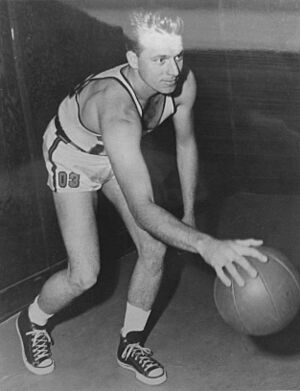
The Royals won the NBA championship in 1951 by beating the New York Knicks 4–3. This is the only NBA championship in the team's history. Even with this win, the team struggled to make money in Rochester. In 1955, they moved to a larger arena, the Rochester War Memorial. The NBA even held its All-Star Game there in 1956. But the team was losing games, and the NBA wanted them to move to a bigger city. The 1956–57 season was their last in Rochester.
Many future Hall of Fame players played for the Royals in Rochester. These included Al Cervi, Bob Davies, Red Holzman, Arnie Risen, Maurice Stokes, Jack Twyman, and Bobby Wanzer.
1957–1972: Cincinnati Royals Era
In April 1957, the Royals moved to Cincinnati. The city was excited about getting an NBA team. The team kept the "Royals" name, which fit Cincinnati, often called the "Queen City."
The team added Clyde Lovellette and George King. They joined Maurice Stokes and Jack Twyman. However, a serious injury to star player Maurice Stokes deeply affected the team. Six players retired because of this. Jack Twyman helped Stokes with his medical care until Stokes passed away in 1970. Their story was made into a film called Maurie in 1973.
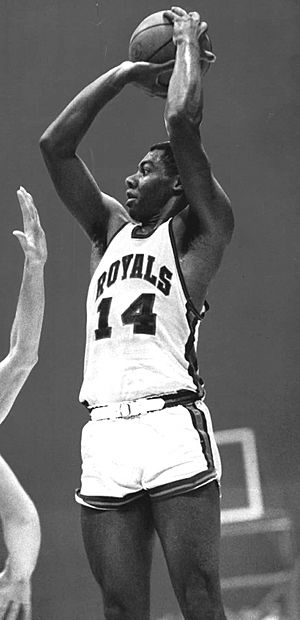
In 1960, the team drafted local superstar Oscar Robertson. Robertson led the team, which included Twyman and Jerry Lucas. The Royals became a top team. From 1963 to 1966, they played well against the Boston Celtics and Philadelphia 76ers. Robertson was a leading scorer and passer. Lucas was the Rookie of the Year in 1964.
By the 1966–67 season, the Royals started playing some home games in other cities like Cleveland and Dayton. This hurt their fan base in Cincinnati. In 1968, owner Louis Jacobs passed away. His sons took over.
New coach Bob Cousy traded Lucas in 1969 and Robertson in 1970. These trades were not popular with fans. Attendance dropped, and the team decided to move to Kansas City. Their last game in Cincinnati was on March 24, 1972.
1972–1985: Kansas City Kings Era
After moving to Kansas City, the Royals changed their name to the Kings. This was to avoid confusion with the baseball team, the Kansas City Royals. They were first called the Kansas City–Omaha Kings because they played games in both Kansas City and Omaha, Nebraska. In 1975, they became just the Kansas City Kings. They moved into the new Kemper Arena.
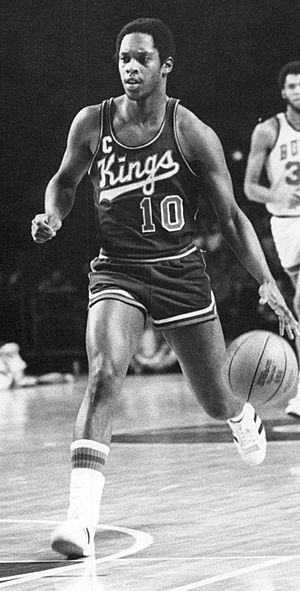
The team gained a new star in point guard Nate Archibald. He led the league in scoring and assists in the 1972–73 season. The Kings had other good players like Sam Lacey, who was a great passing center. Archibald became the first player to lead the league in both scoring and assists in the same season.
The Kings found success when they hired Cotton Fitzsimmons as coach. They won the Midwest Division in 1978–79. Key players included rookie point guard Phil Ford, shooting guard Otis Birdsong, and forward Scott Wedman.
The Kings made the playoffs in 1979–80 and 1980–81. In the 1981 NBA playoffs, they reached the Western Conference finals. This was their first playoff win since 1964. They beat the Phoenix Suns in seven games. However, they lost to the Houston Rockets in the Conference Finals.
The team faced challenges like losing key players and low attendance. Fans in Kansas City preferred college basketball teams like the Kansas Jayhawks and Missouri Tigers.
On June 8, 1983, the team was sold to a group from Sacramento, California. This group was led by Joseph Benvenuti and Gregg Lukenbill. They planned to move the team to Sacramento. The NBA officially approved the move on April 16, 1985.
1985–1998: Sacramento Kings Beginnings
The Kings moved to Sacramento, California for the 1985–86 NBA season. They made the playoffs in their first Sacramento season but then struggled for many years. They did not make the playoffs again until the 1995–96 season. Some challenges included injuries to players like Bobby Hurley and the sad passing of Ricky Berry in 1989.
1991–1998: The Mitch Richmond Era
The early 1990s were tough for the Kings. They had strong fan support at home but struggled on the road. Things improved when they got Mitch Richmond from the Golden State Warriors. Richmond was a former NBA Rookie of the Year and became an All-Star six times with the Kings. Garry St. Jean became the new coach in 1992.
Other players like Spud Webb and Brian Grant played for the Kings during the 1990s, but they often stayed for only a few years. The team made the playoffs in 1996 but lost to the Seattle SuperSonics. Richmond was traded to the Washington Wizards in May 1998 for Chris Webber. This trade was important for the team's future success.
1998–2006: "The Greatest Show on Court"
The Kings drafted Jason Williams in 1998, signed Vlade Divac, and traded for Chris Webber. They also had Peja Stojaković, who had been drafted in 1996. These moves were made by general manager Geoff Petrie.
With new coach Rick Adelman, the Kings played an exciting, fast-paced style of basketball. They were known for their quick passes and teamwork. Many fans loved watching Williams and Webber play together. In 1998–99, they had their first winning season in Sacramento. Webber led the league in rebounds. In the playoffs, they lost to the Utah Jazz.
In 1999–2000, the Kings traded for veteran guard Nick Anderson. They finished eighth in the Western Conference and lost to the Los Angeles Lakers in the first round of the playoffs.
The next season, the Kings traded for Doug Christie to improve their defense. Stojaković became a starter. The team continued to get better, and Sports Illustrated called them "The Greatest Show on Court." They won 55 games, their best record in 40 years. They won their first playoff series in 20 years against the Phoenix Suns but then lost to the Lakers.
In July 2001, Jason Williams was traded for Mike Bibby. Bibby brought more control to the point guard position. The Kings also signed Webber to a long-term contract. With Bibby, they had their best season in 2001–02, finishing with a league-best record of 61–21. They won their first two playoff series easily. Then, they played the Lakers in the Western Conference Finals. This was a very close and exciting series. The Kings lost in seven games, just one game away from the NBA Finals. This loss was very tough for the team and fans.
The Kings won 59 games and their division in the next season. They hoped to get back to the Finals. They beat the Jazz in the first round. But in game 2 against the Dallas Mavericks, Chris Webber suffered a major knee injury. The Kings lost the series in seven games. Webber's injury affected his play when he returned in 2003–04. Despite this, the Kings still beat the Mavericks in the first round. They then lost to the Minnesota Timberwolves in seven games.
2004–2006: Team Changes
The 2004–05 season brought many changes. Divac signed with the Lakers, and Christie was traded. Webber was traded to the Philadelphia 76ers. The team struggled and lost in the first round of the playoffs to the Seattle SuperSonics.
In 2005–06, the Kings traded Stojaković for Ron Artest. Artest helped the team play much better after the All-Star break. They finished with a winning record of 44–38 and made the playoffs as the 8th seed. They lost to the San Antonio Spurs 4–2. This marked the end of their successful era and the start of a 16-year playoff drought. Coach Rick Adelman's contract was not renewed.
2006–2012: New Players and Challenges
The 2006–07 season was difficult. The Kings finished 33–49 and missed the playoffs for the first time in eight seasons. Coach Eric Musselman was fired. The team's future looked to be on the shoulders of Kevin Martin.
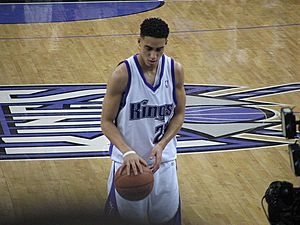
In 2007, former Kings player Reggie Theus became the new head coach. The Kings drafted Spencer Hawes. They also traded Mike Bibby, who was the last player from the 2002 Western Conference Finals team. The Kings finished the 2007–08 season 38–44 and missed the playoffs again.
Reggie Theus was fired during the 2008–09 season. The Kings ended up with the worst record in the NBA at 17–65.
2009–2012: Arrival of Tyreke Evans and DeMarcus Cousins
In the 2009 NBA draft, the Kings drafted Tyreke Evans. Evans won the NBA Rookie of the Year Award in 2010. He was only the fourth player in NBA history to average 20 points, 5 rebounds, and 5 assists per game as a rookie.
In the 2010 NBA draft, the Kings selected DeMarcus Cousins. Cousins and Evans played well, but the team still struggled, finishing near the bottom of the NBA.
The 2010–11 season had rumors that the team might move to Anaheim. However, the NBA Board of Governors decided against the move.
In the 2011 NBA draft, the Kings traded for the draft rights of Jimmer Fredette. Coach Paul Westphal was fired and replaced by Keith Smart. Rookie Isaiah Thomas became a bright spot, earning a spot on the NBA All-Rookie team. In the 2012 NBA draft, they selected Thomas Robinson. Robinson was later traded to the Houston Rockets.
2013–2015: New Ownership and Changes
On May 16, 2013, the Maloof family agreed to sell the Kings to a group led by Vivek Ranadivé. This group wanted to keep the team in Sacramento. The NBA approved the sale, ending years of rumors about the team moving.
With new ownership, the Kings made many changes. Geoff Petrie and Keith Smart were replaced by Michael Malone and Pete D'Alessandro. Shaquille O'Neal also bought a small share of the team.
In the 2013 NBA draft, the Kings selected Ben McLemore. They also traded Tyreke Evans to the New Orleans Pelicans. They acquired Rudy Gay in a big trade in December. For the 2014–15 season, the Kings added Darren Collison and Ramon Sessions.
After a slow start to the 2014–15 season, coach Michael Malone was fired. Tyrone Corbin took over, and then Hall of Fame coach George Karl replaced him in February 2015. On January 30, 2015, DeMarcus Cousins was named an All-Star. This was the first time a Kings player made the All-Star team since 2004.
2015–2017: DeMarcus Cousins' Rise
On March 3, 2015, former Kings player Vlade Divac became the new vice president of basketball operations. The Kings drafted Willie Cauley-Stein and acquired Rajon Rondo and Kosta Koufos.
On April 14, 2016, coach George Karl was fired. The Kings finished the season 33–49.
The 2016–17 season brought more changes. The Kings moved into their new arena, Golden 1 Center. Dave Joerger was hired as head coach. In the 2016 NBA draft, the Kings selected four players, including Georgios Papagiannis and Skal Labissiere. They also signed several veteran players.
2017–2022: Rebuilding After Cousins
On February 20, 2017, the Kings traded DeMarcus Cousins to the New Orleans Pelicans. The Kings finished the 2016–17 season with a 32–50 record.
In the 2017 NBA draft, the team selected De'Aaron Fox. They also drafted Justin Jackson and Harry Giles. To help the young players, the team signed veterans like Vince Carter, Zach Randolph, and George Hill.
The team finished the 2017–18 season with a 27–55 record. In the 2018 NBA draft, the Kings selected Marvin Bagley III. The team finished the 2018–19 season with a 39–43 record, their best since 2006. However, they still missed the playoffs. Coach Joerger was fired and Luke Walton was hired.
The Kings were one of the teams invited to the NBA Bubble in 2020 to finish the season. They missed the playoffs for the 14th season in a row.
2020: Monte McNair Arrives
On August 14, 2020, general manager Vlade Divac resigned. Monte McNair was hired as the new general manager on September 17, 2020.
In the 2021 NBA draft, the Kings selected Davion Mitchell to improve their defense.
On November 22, 2021, head coach Luke Walton was fired and Alvin Gentry became the interim coach. For the 16th season in a row, the Kings missed the playoffs. This became the longest playoff drought in NBA history. The Kings also traded Tyrese Haliburton for Domantas Sabonis. After the season, Gentry was fired.
2022–2025: Fox and Sabonis Era
On May 9, 2022, Mike Brown was announced as the next head coach. He joined the team after winning the 2022 NBA championship with the Golden State Warriors. During the 2022–23 season, the Kings started lighting a large purple beam into the sky after every home win. This led to fans chanting "Light the Beam!"
Both De'Aaron Fox and Domantas Sabonis were named All-Stars. On February 24, 2023, the Kings beat the Los Angeles Clippers in a very high-scoring game, 176–175. This was the second-highest scoring game in NBA history. On March 29, the Kings beat the Portland Trail Blazers to make the playoffs. This ended their 16-year playoff drought. In the playoffs, they lost to the Golden State Warriors in seven games. Mike Brown was named NBA Coach Of The Year.
In the 2023–24 season, the Kings finished 46–36. They made the play-in tournament, beating the Warriors but losing to the New Orleans Pelicans.
In the offseason, the team acquired 6-time All-Star DeMar DeRozan. After a slow start to the 2024–25 season, the Kings fired Mike Brown. On February 3, 2025, the Kings traded De'Aaron Fox to the Spurs and acquired Zach LaVine from the Bulls.
Team Look: Logos, Uniforms, and Colors
Rochester Royals Look
The first Rochester Royals logo was a blue and white shield with "ROCHESTER" and "ROYALS" on it. Their road uniforms were blue with the city name, and home uniforms were white with the team name. Red colors were added later.
Cincinnati Royals Look
When they moved to Cincinnati in 1957, the logo became a basketball with a cartoon face wearing a crown. The uniforms stayed blue on the road and white at home, with red accents.
In the late 1960s, the Royals wore uniforms with the team name written vertically. In 1971, they changed to a red crown logo. The uniforms then had a script "Royals" on the front.
Kansas City Kings Look
When the team moved to Kansas City in 1972, they kept their uniforms and logos, just changing the name. Later, they changed their road uniforms to show the city name.
Sacramento Kings Look
After moving to Sacramento in 1985, the Kings kept the red, white, and blue colors. The crown logo was also carried over. For five seasons, the home uniforms used royal blue, and the road uniforms used powder blue.
Purple and Black Era
In 1994, the Kings completely changed their look. They started using purple, silver, black, and white. Their home uniform was white, and the road uniform was black. They also had a purple alternate uniform starting in 1997–98.
Before the 2002–03 season, the Kings updated their uniforms again. They had a modern "Kings" script on the home jersey and the city name on the purple road jersey. In 2005–06, they added a gold alternate uniform.
In 2008, the team introduced new uniforms. The road jersey had "Kings" in black text, and the home jersey had "Sacramento" in white text. In 2011–12, a black alternate uniform was added.
For the 2014–15 season, the Kings made small changes. They brought back the 1994–2002 "Kings" script on both uniforms. A gold tab was added to the back of the jersey to show their 1951 NBA championship.
For the 2016–17 season, the Kings changed their logo to look more like their 1971–1994 design. They removed black from their logo but kept purple and silver. They unveiled new uniforms with four designs.
Starting in 2017–18, the jerseys were sponsored by Blue Diamond Growers. The NBA changed uniform rules, so the Kings now have white 'Association' uniforms, purple 'Icon' uniforms, and black 'Statement' uniforms.
The Kings updated their uniforms for the 2023–24 season. Black became the main color, and purple was an accent. The new "Kings" script was inspired by uniforms from 1972 to 1994.
Special Edition Uniforms
Nike also releases special 'City' uniforms each year.
- 2017–18: White and powder blue with red trim, like their 1985–1990 road uniforms.
- 2018–19: Replaced the lion-head logo with "Sactown."
- 2019–20: Red base with powder blue trim.
- 2020–21: Black base with checkerboard patterns, powder blue, and red trim.
- 2021–22: "Sactown" script and off-centered numbers, black base, purple trim, and a tribute to the Rochester Royals logo.
- 2022–23: Gray base and purple trim, inspired by the Golden 1 Center.
- 2023–24: Blue base with a vertical "Kings" wordmark, red borders, and silver sleeve stripes. This celebrated the team's 100th anniversary.
- 2024–25: Revisited the Cincinnati theme with "Kings" block lettering.
Classic Uniforms
The Kings have worn throwback uniforms to honor past teams:
- 2002–03: 1960s Cincinnati Royals white uniform.
- 2003–04: Mid-1970s Kansas City Kings white uniform.
- 2004–05: Mid-1980s powder blue jerseys.
- 2010–11: 1950–51 Rochester Royals championship team uniforms.
- 2019–20: Blue uniforms from 1990 to 1994.
- 2024–25: Purple uniform style from 2002 to 2008.
Team Mascot
Since the 1997–98 season, the Kings' official mascot has been Slamson the Lion. Before that, their mascot was "The Gorilla."
Season Records
Here are the last five seasons for the Kings:
| Season | GP | W | L | W–L% | Finish | Playoffs |
| 2020–21 | 72 | 31 | 41 | .431 | 5th, Pacific | Did not qualify |
| 2021–22 | 82 | 30 | 52 | .366 | 5th, Pacific | Did not qualify |
| 2022–23 | 82 | 48 | 34 | .585 | 1st, Pacific | Lost in first round, 3–4 (Warriors) |
| 2023–24 | 82 | 46 | 36 | .561 | 4th, Pacific | Did not qualify |
| 2024–25 | 82 | 40 | 42 | .488 | 4th, Pacific | Did not qualify |
Home Arenas
The Kings have played in many different arenas throughout their history:
- Edgerton Park Arena (1949–1954)
- Rochester War Memorial (1955–1957)
- Cincinnati Gardens (1957–1972)
- Omaha Civic Auditorium (1972–1978)
- Kansas City Municipal Auditorium (1972–1974 & 1979–1980)
- Kemper Arena (1974–1985)
- ARCO Arena I (1985–1988)
- ARCO Arena II (1988–2016)
- Golden 1 Center (2016–present)
Team Rivalries
Los Angeles Lakers
The Kings and the Lakers have played each other in the playoffs nine times. Since the Kings moved to Sacramento in 1985, both teams are based in California. The 2002 Western Conference Finals was a very intense series with many controversial calls. The Lakers won the series in game 7.
Golden State Warriors
Since the Kings moved to Sacramento in 1985, they have a local rivalry with the Golden State Warriors. Both teams are in Northern California, about 86 miles apart. Even though both teams have been around for a long time, they did not play each other in the playoffs until 2023. They faced off in the first round. It was a tough series, and the Warriors won in seven games. This series was very popular and had high TV ratings.
Team Personnel
Retired Numbers
The Kings have honored several players by retiring their jersey numbers. These numbers hang in the Golden 1 Center.
| Sacramento Kings retired numbers | ||||
| No. | Player | Position | Tenure | Retired |
|---|---|---|---|---|
| 1 | Nate Archibald | G | 1970–1976 | February 6, 2004 |
| 2 | Mitch Richmond | G | 1991–1998 | December 5, 2003 |
| 4 | Chris Webber | F | 1998–2005 | February 6, 2009 |
| 6 | Fans ("The Sixth Man") | — | 1985–present | 1986–87 |
| 11 | Bob Davies | G | 1945–1955 | 1989–901 |
| 12 | Maurice Stokes | F | 1955–1958 | |
| 14 | Oscar Robertson | G | 1960–1970 | February 16, 2003 |
| 16 | Peja Stojaković | F | 1998–2006 | December 16, 2014 |
| 21 | Vlade Divac | C | 1999–2004 | March 31, 2009 |
| 27 | Jack Twyman | F | 1955–1966 | |
| 44 | Sam Lacey | C | 1970–1981 | |
- 1 Number was temporarily unretired for Domantas Sabonis since 2024.
- The NBA retired Bill Russell's No. 6 for all its member teams on August 11, 2022.
Hall of Fame Players and Coaches
Many players and coaches who were part of the Kings franchise have been inducted into the Naismith Basketball Hall of Fame.
| Sacramento Kings Hall of Famers | |||||||||
|---|---|---|---|---|---|---|---|---|---|
| Players | |||||||||
| No. | Name | Position | Tenure | Inducted | No. | Name | Position | Tenure | Inducted |
| 11 | Bob Davies | G | 1945–1955 | 1970 | 19 | Bob Cousy1 | G | 1969–1970 | 1971 |
| 14 | Oscar Robertson 2 | G | 1960–1970 | 1980 | 16 | Jerry Lucas 3 | F/C | 1963–1969 | 1980 |
| 10 27 31 |
Jack Twyman | F | 1955–1966 | 1983 | 9 09 |
Bobby Wanzer | G | 1948–1957 | 1987 |
| 34 | Clyde Lovellette | C/F | 1957–1958 | 1988 | 1 10 |
Nate Archibald | G | 1970–1976 | 1991 |
| 14 | Arnie Risen | C | 1948–1955 | 1998 | 12 | Maurice Stokes | F | 1955–1958 | 2004 |
| 50 | Ralph Sampson | C | 1989–1991 | 2012 | 5 | Guy Rodgers | G | 1967–1968 | 2014 |
| 2 | Mitch Richmond | G | 1991–1998 | 2014 | 13 | Šarūnas Marčiulionis | G | 1995–1996 | 2014 |
| 12 | Jo Jo White | G | 1980–1981 | 2015 | 21 | Vlade Divac | C | 1998–2004 | 2019 |
| 4 | Chris Webber | F | 1998–2005 | 2021 | 15 | Vince Carter | G/F | 2017–2018 | 2024 |
| Coaches | |||||||||
| Name | Position | Tenure | Inducted | Name | Position | Tenure | Inducted | ||
| Pete Carril | Assistant coach | 1996–2006 2008–2012 |
1997 | 5 | Rick Adelman 5 | Head coach | 1998–2006 | 2021 | |
| Bill Russell 6 | Head coach | 1987–1988 | 2021 | George Karl | Head coach | 2015–2016 | 2022 | ||
| Contributors | |||||||||
| Name | Position | Tenure | Inducted | Name | Position | Tenure | Inducted | ||
| Les Harrison | Head coach Owner |
1948–1955 | 1980 | 15 32 34 |
Wayne Embry 4 | C | 1958–1966 | 1999 | |
| Cotton Fitzsimmons | Head coach | 1978–1984 | 2021 | ||||||
Notes:
- 1 He also coached the team from 1969–1973.
- 2 Robertson was inducted into the Hall of Fame twice: as a player and as a member of the 1960 Olympic team.
- 3 Lucas was inducted into the Hall of Fame twice: as a player and as a member of the 1960 Olympic team.
- 4 Inducted for being the first African American to manage a team in the NBA. He also played for the team from 1958–1966.
- 5 Also played for the team (1975).
- 6 Russell was inducted into the Hall of Fame twice: as a player and as a coach.
FIBA Hall of Famers
Some Kings players have also been inducted into the FIBA Hall of Fame, which honors international basketball stars.
| Sacramento Kings Hall of Famers | ||||
|---|---|---|---|---|
| Players | ||||
| No. | Name | Position | Tenure | Inducted |
| 14 | Oscar Robertson | G | 1960–1970 | 2009 |
| 21 | Vlade Divac | C | 1999–2004 | 2010 |
| 13 | Šarūnas Marčiulionis | G | 1995–1996 | 2015 |
See also
 In Spanish: Sacramento Kings para niños
In Spanish: Sacramento Kings para niños


